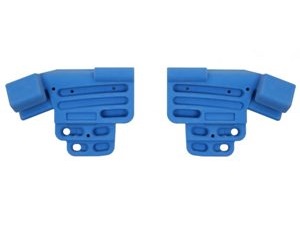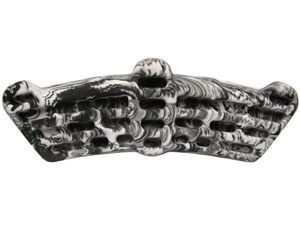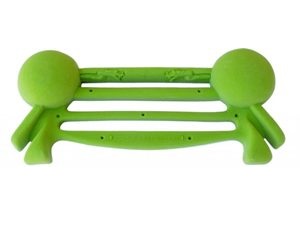The Best Climbing Hangboard for 2022
It is difficult to overstate just how important developing forearm and finger strength can be for a rock climber. As beginners, most people take on routes that are clearly marked, easy to follow, and feature large hand and footholds. But as their skill and experience levels increase, they inevitably find themselves on more difficult and demanding routes where the hand- and footholds are reduced to just the thinnest of cracks and edges. To overcome these challenges, strong fingers are essential.
While it may seem counter-intuitive, many climbers don’t necessarily start off with an already amazing grip. Instead, they develop their forearm, hand, and finger strength over time. That said, most of us can’t get to the climbing gym or rock face every day, so building that strength can take a very long time. Fortunately, there are some tools and exercises that we can do at home to speed up that process. The most useful way to do that is to start using a hangboard.
What is a Hangboard?
In the late 1970s and early 80s, rock climbers would often nail small blocks of wood to the walls of their home. Those pieces of wood served as grips and holds for them to practice their technique and build strength, even when they didn’t have time to head to the crag.
This approach proved to be highly effective, even if it was a bit crude. By the mid-1980s, however, some of the more innovative climbers began shaping those pieces of wood to simulate the cracks and edges they were using in the wild. From this simple concept, the modern hangboard—or fingerboard as it is sometimes called— was born.
Today’s hangboards come in a wide variety of shapes and sizes. Many are still made out of wood, although there is an increasing assortment molded from hard plastic resin. The surface of the board is usually smooth, with grooves and holes of varying length, depth, and thickness carved out of it. Those grooves and holes are often barely big enough to accommodate a climber’s fingers, providing just enough space to create a precarious hold to hang on to.
How to Use a Hangboard
Like those blocks of wood used by climbers in the 70s and 80s, a hangboard is hung on the wall over an open space. Many climbers will mount their hardboards above a doorway, roof beam or an open stairwell, as this leaves enough room for them to dangle—or hang—from the board while using it.
Once the hangboard is nailed in place, a climber can then use it as a very focused and intense workout tool. By gripping any of the grooves or holes, they can work on improving their grip and forearm space, something that translates well to climbing in the gym or outdoors. Typical exercises include fingertip or two-finger pull-ups, as well as just rotating through the various holds while letting your body hang in mid-air.
When first adding a hangboard workout to your exercise regimen, it is important to take things slow, develop good techniques, and not overdo it. A climber should be able to hang from the board while keeping their shoulders well away from their ears. It is important to maintain control at all times, using their shoulder blades to provide support to the fingers and forearms, while preventing the elbows from locking up.
At first, this will feel awkward and unsteady. But over time, as the strength and technique improve, it will become much easier. That will be a clear sign that the strength in the fingers, hands, and forearm are improving.
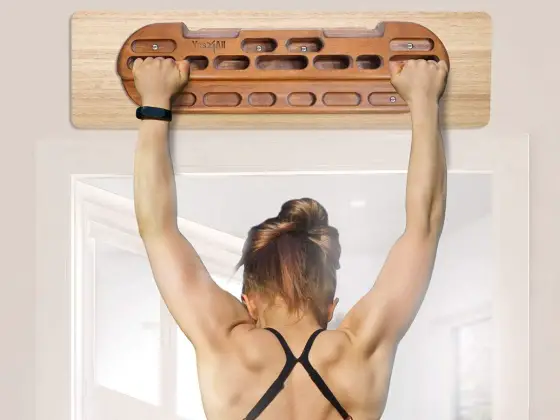
What to Look for in a Hangboard
When deciding which hangboard is right for you, there are a number of factors to consider. One of the most important things to look at is the number and type of holds that a board has to offer. You’ll want one that provides plenty of versatility and variety, not only to mix up the types of exercises you’ll be doing but also to simulate the real-world conditions you might encounter when on a climbing route.
You’ll also want to consider how the hangboard mounts to your wall. Most modern models come with the tools and supplies you need to attach them to just about any surface, but some are better suited for hanging over a door than others. Knowing where you’ll be using it can play a key role in which board you end up purchasing.
Finally, you’ll also want to think about what type of material you want your hangboard to be made from. Wooden boards are often very comfortable to use for instance, but they don’t always offer a secure grip and can have limited options when it comes to the types of holds they provide. Conversely, hangboards made of resin are often larger and have a wide variety of grooves and edges, but they can be less comfortable to use during longer workouts.
Our advice is to try a few different types of boards out to see which ones align most closely with your own preferences and needs. At the very least, this is usually a good way to settle the wood vs. resin debate.
The Best Hangboards for 2022
Back in the 80s and 90s, climbers usually had to build their own hangboards, carving and cutting custom versions designed to meet their specific needs. Things have changed quite a bit since then, with many of the top climbing gear companies now producing models of their own.
This has made it easier than ever to add one of these boards to your climbing workout, although the question remains as to which model to get. If you’ve been pondering that very question, we have compiled our list of the best hangboards for 2021 to help you decide.
1 Trango Rock Prodigy Training Center

| Material | Polyurethane Resin |
| Hold Types | 15+ unique grips |
Built with both beginner and experienced climbers in mind, the Trango Rock Prodigy Training Center is perfect for anyone who is looking to take their skills to the next level. The sheer number and variety of holds that are incorporated into this model is a bit mind-blowing, allowing climbers to continually mix up their workouts to suit their needs. The numerous cracks, edges, and pockets also make this hangboard quite possibly the only one you’ll ever need, allowing growth and progression over time.
One of the things that set the Rock Prodigy apart from the competition is its unique two-piece design. This makes it a bit more challenging to mount on the wall, but gives climbers the ability to customize it to fit their specific shoulder width. Its supportive polyurethane resin material is supportive and comfortable too, making it easy to use for extended periods of time.
2 Metolius Simulator 3D

| Material | Polyurethane Resin |
| Hold Types | Jugs, pockets, and slopers |
The Metolius Simulator 3D hangboard is one of the best-selling and most popular in the world—and for good reason. This model is extremely beginner-friendly and is a good training aid for intermediate-level climbers too. Advanced users will love the variety of grips that this hangboard offers, but may find that the holds are a bit too wide. If you’re looking to improve your game on narrow cracks and edges, the Simulator 3D probably isn’t the right choice for you.
That said, this model is very easy to mount, comfortable to use, and provides a solid grip. Its variety of holds is a real strength too, delivering a level of variety that isn’t found on many of its competitors. This allows climbers to make steady progress in terms of honing their abilities. As an added bonus, the board’s symmetrical design helps climbers to maintain good form, which in turn helps to minimize the chances of an injury. Add in a sub-$80 price tag and you get a training tool that happens to be a real bargain too.
3 So iLL Iron Palm

| Material | Polyurethane Resin |
| Hold Types | Slopers and pinchers |
At first glance, the Iron Palm from So iLL is a model that looks like it doesn’t have much to offer in terms of holds and grips. But after using it for a bit, you soon discover that it far more complex and useful than it would initially appear. Instead of focusing on small cracks and thin edges, this mode instead offers a set of excellent slopers and pinchers, allowing rock athletes to not just improve their strength and fitness, but expand their climbing repertoire into entirely new areas.
The design element that stands out the most on this hangboard is the two large spheres located at either end. The two balls happen to be flat on top and slope gently to the sides, creating a unique training tool that isn’t commonly found on most other models. Combine this feature with some of the best pinchers found on any board on the market and you end up with a board that is built to expand a climber’s skillset. Combine the Iron Palm with a more traditional hangboard for an incredibly well-rounded workout routine.
4 Metolius Wood Grips Deluxe II
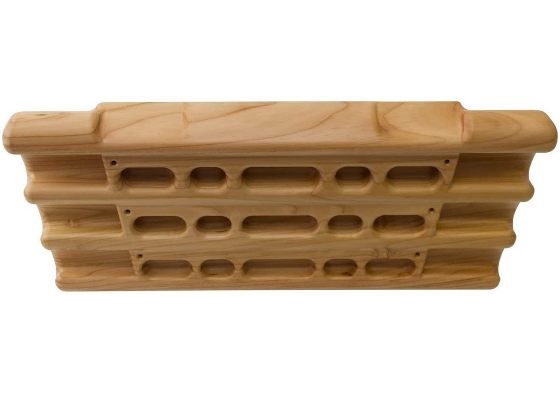
| Material | Wood |
| Hold Types | Edges, jugs, and slopers |
While wooden hangboards are becoming harder and harder to find these days, there are still a few excellent models to be found. One of the best is the Metolius Wood Grips Deluxe II, which manages to pack a surprising number of features into an efficient, aesthetically pleasing design.
Comparatively speaking, the Wood Grips offers fewer holds than its plastic counterparts. That said, there are still plenty of edges, pockets, and slopers to even keep advanced climbers progressing towards their goals. The wood used in its construction is smooth to the touch, yet still has a natural texture that enhances the grip. Its smaller size also makes it easier to mount, while it classic good looks allow it to subtly blend in with its surroundings, particularly compared to some of the more flashy-looking hangboards on the market.
5 Atomik Yaniro Power
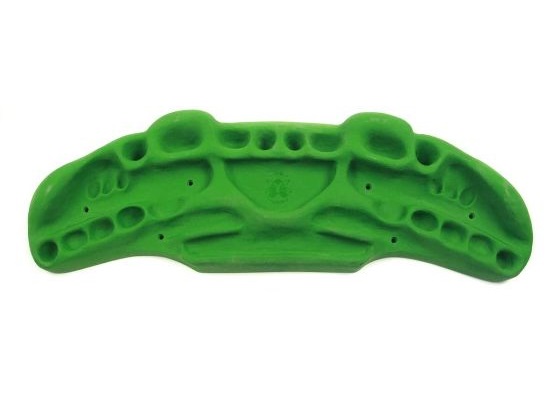
| Material | Plastic |
| Hold Types | Edges, pockets, slopers, and jugs |
If you’re an advanced climber who feels like your training and progression has plateaued, the Atomik Yaniro Power just might help you get things back on track. This model features a wide variety of holds that are decidedly on the more difficult side. That isn’t to say that beginners and intermediate climbers won’t gain anything by using it too, but because of its challenge level, it can be frustrating for less experienced athletes.
In addition to its high level of difficulty, the Yaniro Power has other features that help it stand out from the crowd. For instance, it has a great texture and feel that makes it a joy to use. It is also very durable and easy to install, although it does take up more room on the wall than some of the other options. If you’re a strong climber who can take advantage of everything it brings to the table, however, this is a top-notch product.
6 Escape Climbing Unlimited
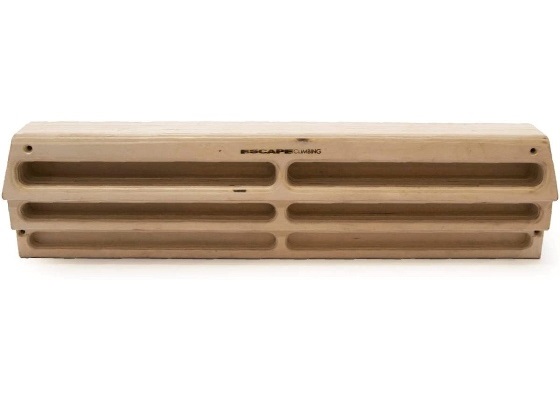
| Material | Wood |
| Hold Types | Edges and slots |
Yet another high-quality wooden hangboard, the Escape Climbing Unlimited is versatile, easy to mount, and looks like a work of art. The handcrafted board is not only extremely good looking but is very durable too. In fact, it hardly looks like a hangboard at all, which allows it to fit in nicely in environments outside of the gym.
Best for beginner and intermediate climbers, the Unlimited seems fairly simple and—well—limited at first. But, its tapered design, along with its variety of edges and slots, give it a higher level of complexity than it would first seem. The varying depth of those slots do a good job of simulating real-world experiences too, allowing your training to seamlessly transfer to use on the crag.
7 Metolius Project
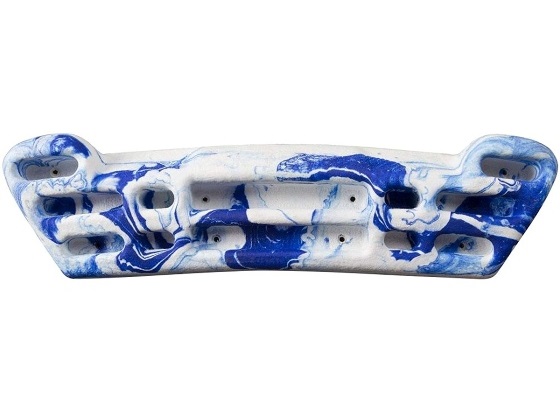
| Material | Polyurethane Resin |
| Hold Types | Jugs, pockets, and slopers |
If you couldn’t tell by now, Metolius makes a broad range of hangboards that come in varying sizes, styles, and price points. The Project is another board from the company’s catalog that manages to deliver quite a lot of value. It also happens to be fairly beginner-friendly, thanks in part to its simple—but limited—design.
Because the Project is smaller than most other hangboards on the market, it is rather unobtrusive when hanging on the wall. But that compact size also means there is less space for additional holds. Metolius makes the most of the space that has, but there are other boards that provide more variety. Still, there is a nice set of grips to be had here, particularly for a product that comes in at under $60. That makes it a budget-friendly option for anyone looking for good, reliable training aid, without putting too much of a strain on their wallet.
8 Beastmaker 2000
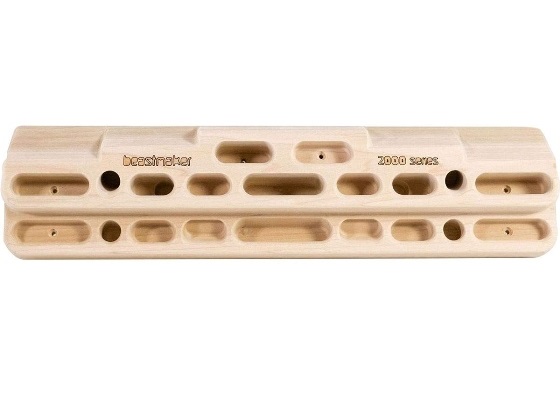
| Material | Wood |
| Hold Types | Jugs, pockets, and slopers |
One of the more full-featured wooden boards on the market, the Beastmaker 2000 lives up to its name. This is the kind of hangboard that a climber can grow and progress with, not only due to the wide variety and sizes of holds but the angles that those holds offer too. Working your way through all of those grips will take time and practice, but that helps this board to serve as a measuring stick of sorts, helping climbers to check their progress.
The Beastmaker’s design helps set it apart from the numerous plastic resin models, even if it isn’t quite as elegant as some of the other wooden boards. Instead, it chooses to focus on providing the best training experience possible, packing a lot of options into a relatively compact space. If you’re looking to take your climbing to the next level, this is a board that can help you achieve that goal.
9 Escape Climbing Beta

| Material | Polyurethane Resin |
| Hold Types | edges and pockets |
The Escape Climbing Beta Board has been an institution in climbing gyms for years, and yet it remains one of the best hangboards on the market. Simple and well designed, it offers a limited, but still well-rounded, a number of holds to assist in building core climbing strength and better technique. So much so that a beginner could purchase this model and continue to find it effective even as they advance in skill level.
One of the things that set the Beta Board apart from the crowd is its dual-textured coating. Designed to provide a steady grip, without destroying your skin, this hangboard is easy to hold on to, without inflicting painful cuts, tears, and abrasions. It is so good in fact, that after using it a time or two, you’ll wonder why more boards don’t use a similar approach. It is a real game-changer for those who are frequently training at home or in the gym.
10 Yes4ll Rock Climbing Hangboard
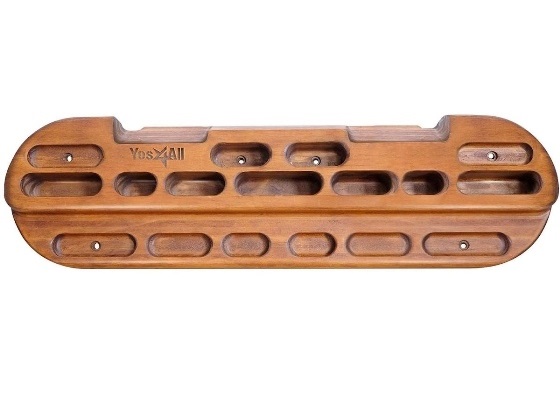
| Material | Wood |
| Hold Types | jugs, pockets, and slopers |
If you’re looking for a high-quality wood board at an affordable price, the Yes4All Hangboard certainly fits that description. Good looking and easy to install, this is a model that has something to offer both beginner and advanced climbers, with a wide variety of holds and edges to experiment with. That includes five individual sets of finger holds for building strength and endurance.
Despite the fact that this board looks like it is smooth and slick, each of the holds has been given a slight texture. This makes it surprisingly easy to hold onto during a workout, making it an effective tool for training. This is especially true since it offers many of the same features and functionality as more expensive boards at a fraction of the price.
How to Choose a Hangboard
When you’re first starting to climb, it’s easy to get overwhelmed by all the gear that is needed for this sport. One of the most important pieces of equipment a climber can invest in is a hangboard. These boards are designed specifically for climbing and help climbers build strength and power while mimicking some of the movements they make when on the wall. Choosing a hangboard can be tough but with these tips you’ll be able to choose one that works best for your needs!
Check the Material the Hangboards is Made of
More often than not, hangboards are made from either plastic or wood.
A wooden Hangboard:
Some of the most common wooden hangboards are beastmaker 1000 and beastmaker 2000. They are soft and friendly to your skin. Their downside is that they are expensive and had come by.
Both the wooden and the plastic hangboad offer similar feeling when your are training with them. But if you are comfortable using either of the two, the material used in making them doesn’t really make a difference.
A Plastic Hangboard:
Plastic hangboards are almost always made out of polyester resin or a similar material. However it does not seem like there’s much difference between a plastic and a wooden hangboard in terms for which has more abrasive qualities versus another one – either of the two make a good training board and will get you your desired results if taken care off properly.
Check the Hangboard’s Difficulty Level
Choosing the difficulty level of a hangboard can be a little tricky, but there are a few key things to look for. The number of grips, the angle of the grips, and the thickness of the board will determine what level it is. For example, a beginner hangboard will have one or two grips that are 12-14 inches up, while an expert board might have grips 15-20 inches up.
The angles of grips also make a difference in terms of difficulty because steeper angles means more difficult hangs. A beginner training board will have holds at about 35 degrees, while an expert training board might have holds at 45 degrees. Finally, thicker boards provide more advanced climbers with room for advanced problems and finger strength exercises.
Consider the Size of the Space You Intend to use the Hangboard on
The size of the space that you intend to use the hangboard on is an important consideration. For instance, if you have a lot of room but need to keep your home gym discreet, then a no-profile wall mounted hangboard might be what you are looking for. On the other hand, if your goal is to have the most expansive possible workout area in your home or garage gym, then it would make sense to invest in any big hanging boards which can accommodate any height and width.
Hangboards are available with different lengths as well. If purchasing a board that will attach directly onto drywall or studs in an existing wall, consider getting one that has adjustable arms so that it can fit into any wall.
Consider Your Strengths, Weaknesses and Climbing Styles
In order to get the most out of your board and train efficiently, you need to consider how it will work with your strengths and weaknesses as well as what kind of climbing style you usually go for.
For example, if you’re strong on crimps but weak on slopes, then a board with lots of edges is going to be better than one with tons of pinches and pockets. Likewise if you love doing overhangs but don’t like doing pull-ups then a board built for campus training might be more up your alley than one meant for power training.
Choose a hangboard that suits your climbing style, capabilities and that helps you accomplish your climbing goals.
4 Simple Hangboards Training Tips to Help You Practice at Home
When you are doing a climbing training, your main goal is to get stronger and climb harder. You can do that through hangboard training or campus board training at the gym, but some people just don’t have access to a gym with these resources. This means they must practice their hangboard training at home! If you’re would like to train on an indoor wall without having access to the proper equipment, there are ways for you to still improve your strength while practicing at home.
Here are 4 simple tips on how you can successfully stay strong while using a hangboard even when not in a rock climbing gym!
1- Identify Your Abilities and Limits
Before you start practicing hangboard training at home, it is essential to identify your abilities and limits. This will determine the level of difficulty that you should be working at. It might be best to start with a beginner board if you haven’t been practicing a lot or a more advanced board if you have been climbing for a while. However, don’t spend too much time on beginner hangboards because they won’t challenge your abilities enough to get stronger. Make sure that you are going up in difficulty as you get stronger.
After you have advanced from the beginner level to an advanced level, walk yourself down back to the beginner level to allow your fingers and tendons to relax.
2- Draft a Plan That Suits You and Follow It
While it is easy to for beginners to follow a plan, don’t slack when it comes to planning out your training. If you know what you want and how you can achieve it, then draft yourself a plan that that serves you best. In your plan, you can indicate the type of the exercise you intend to take, the time needed to take it and the expected progress within a given period.
3- Find Some Motivation
Motivation is key to staying strong when you’re hangboarding on the wall. At home, there are some things you can do to motivate yourself that might not come as naturally as those available in a rock climbing gym. For instance, you can set a timer for 10 minutes and commit yourself to doing as many sets as possible during that time frame.
You can also bring photos of friends or family members who will be proud of your progress. Another option includes finding videos of climbers that inspire you and create an incentive system that require you to complete a couple of sets within a certain time for some prizes.
Start With the Simple Set and Advance With Time
There are many hangboard exercises both in beginner levels and in the advanced level and might be confusing and overwhelming to a beginner wishing to hangboard at home. However you should start with the simpler hangboard set in the beginner level and advance as you become stronger.
This is because it will be easier for you to follow instructions on how to do simple exercises compared to advanced ones. It is also advisable to work with the same set of handboards for a longer period of time. This way, it will be easier for you to track your progress and see whether you are progressing or not. You don’t want to get discouraged because you feel like there is no progress when in fact there is some improvement on your side.
Lastly, don’t focus on too many grip types. Even though we recommend that you work on all the different grips, we also advise that you don’t spread yourself too thin and focus on too many at a time. It will be too overwhelming to work on many grip types at once because this can lead to losing motivation and getting discouraged if you don’t see immediate progress.
With the above tips at hand, home training is not only made possible, but it can be more effective than visiting the gym. Hangboards workouts are a great way to get in shape while also having fun at home. We hope these 4 hangboards training tips will help you practice effectively and efficiently so that you feel ready for your next climb outdoors!
Stupid Simple Hangboarding Exercises for Beginners and Pros
Hangboarding is an excellent exercise to increase finger strength. It may seem intimidating, but it’s actually very simple and can be done anywhere with some basic equipment. So, how do you get started with hangboarding?
Well let’s explore some stupid simple hangboarding exercises that you can learn immediately and start practicing on your own!
Two Arms Active Hang Progression
The two-arm active hang progression is an excellent way to work on your strength. This exercise will help you build the power needed for pulling/hanging onto your hands.
Here is how to do it:
Step 1: With feet on the ground, pull/push yourself up to a hangboard.
Step 2: Hold and hang on the hangboard for 10 seconds x5 (you may need some assistance by having someone push your feet upwards)
Step 3: Come down slowly with control, don’t just drop back down! You might injure yourself.
Repeat this set until you have done it 5 times.
Pull-ups are one of the most well-known bodyweight exercises that helps bring back focus to muscles that often go ignored in favor of chest/biceps workouts.
One Arm Active Hang Progression
The one-arm active hang progression is an excellent way to work on your strength, grip strength, and muscle engagement. This exercise will help you build the power needed for pulling and hanging onto your hands. However, one arm active hang progression exercise may not be the most appropriate for beginners. But still, it should be the next most appropriate exercise after successfully doing the two-arm active hang progression as you need to build some muscle power to do it.
Here are the steps you need to follow to do the one arm active hang progression:
Step 1: 1. Hang from a hangboard or a pull up bar with one arm.
Step 2: Hold for 60 seconds.
Step 3: Lower to the ground and repeat the same with the other hand.
Step 4: Add weight by holding a plate or dumbbell in your free hand while hanging.
Step 5: Increase difficulty by jumping between two separate hangboards or by adding more time (120 seconds) hanging on one hand while having more weight on the freehand.
Step 6: Continue progressing until you can hang for 1 minute with no assistance from anything else but your own strength!
Offset Hangs Exercise
Offset hangs are a simple but effective exercise for rock climbers. The exercise forms an excellent way to work on your strength in different planes of motion. Offset hangs will help you build the strength needed for pulling/hanging onto and holds in different positions.
The steps for offset hangs are as follows:
Step 1: Hang from two hangboards with your palms facing away from you.
Step 2: Keep your arms straight and let them hang down as if you are holding two heavy grocery bags.
Step 3: Without swinging or kicking out to help yourself up, slowly raise yourself up by pulling on the two hangboards with only the strength of your hands.
Step 4: When you’re at the top position (arms fully extended), pause for one second before lowering back down slowly.
Step 5: Repeat this exercise until failure; then rest and repeat again for 3 sets in total (or more depending on goals and fitness level). You can increase weight resistance by wearing a weighted vest or using ankle weights during these exercises.
Step 5: If you find this exercise too difficult, try doing it without weight first so that your muscles get used to it – then add in some extra weight as you advance.
This exercise helps you build muscle strength needed to lift your body up when you are in a narrow gap when rock climbing.
As you can tell, hangboarding is a great way for climbing training without having to go outdoors or leave the house. You don’t need any special equipment, just some free weights, and some pull up hangboards. Once you’ve learned how to do hangboard exercises properly, you’ll see your strength skyrocket in no time!
How to Avoid Injuring Yourself When Hangboarding.
Hangboarding is an interesting sport and a great way to improve your grip strength and endurance. However, it also puts you at risk for injury if not done properly.
Here are some tips on how to avoid injuring yourself when hangboarding:
1- Warm-up Before Starting the Exercise
Warm up with some easy pull-ups to get the blood flowing. Do 10 pull-ups, rest for 20 seconds, and do another 2 sets of 10 pull-ups. Between workouts, do 5 minutes of light activity like taking a walk or jogging in place to bring blood into the muscles again. To stay injury-free, you should warm-up before each workout, even if it is just five minutes of light activity.
2- Use Half Crimp and Avoid Full Crimp as Much as Possible.
Using full crimp when holding on the hangboards would result in you injuring your tendons on your thumb finger. To avoid this, always use half crimp to protect yourself from injuring your tendons.
3- Keep Your Sholders Off From Your Ears
When you climb, you should keep your shoulders away from your ears. This way, your weight will be distributed evenly, and you won’t have to use as much energy. Plus, it’s a good idea to avoid arching your back too much because that can lead to injury. You also want to make sure not to lock out any joints when climbing, so they don’t get strained or injured either.
4- Slow Your Pace and Avoid Advancing Too First
You will be more likely to fall if you push yourself too hard right off the bat. As with all sports, progression in hangboarding takes time no matter what level of athlete you aspire to become, so take your time while climbing at first!
This way, you will avoid exhausting yourself or injuring your tendons when you push yourself to your limits too soon.
5- Warm Down After hangboarding
Lastly, it is important to warm down. Hangboarding is an intense upper-body workout that can be tough on your joints. But if you don’t take care to warm down, the next day could find you with aches and pains so bad you won’t want to climb at all. And worse still, not warming down afterward may actually cause injury! So it pays to make it a habit to do some gentle stretching after hangboarding sessions.
Hangboarding is a great way to build your grip strength, but it can also be dangerous if you don’t know how to be safe. Follow these five training board safety tips and make sure that when you start this new workout routine, the only injury you get is an awesome workout!
The Hangboard FAQ
What is the difference between a hangboard and a fingerboard?
The term “hangboard” and “fingerboard” are both references to the same type of training tool and can be used interchangeably.
How often should I use a hangboard?
While hangboarding is a great method of training for climbers, it should be done in moderation. Most experts recommend doing no more than two or three hangboard workouts per week in order to avoid injury to the fingers and hands. It is also recommended that climbers take an entire week off on a regular basis too in order to avoid the onset of osteoarthritis, a condition that results in the degeneration of cartilage. In other words, these finger exercises are good, provided you’re not overdoing it.
How do you install a hangboard?
Almost every model of hangboard is different so it is important to follow the included instructions or consult the manufacturer before mounting a hangboard on the wall. However, generally speaking, you’ll want to install your board in a place that allows you to hang freely underneath it while training.
That can include mounting it over a doorway, hanging it from a support beam, or installing an extender from a wall to provide more space. Either way, you’ll want to fasten the board as securely as possible, using wall studs or the frame of a door as an anchor. Just attaching it to a wall may not be secure enough to support a climber’s bodyweight.
Can I mount a hangboard in my apartment?
The short answer is yes, provided your lease or landlord allows it. As already mentioned, you’ll want to secure it to wall studs or a door frame to ensure that it is securely in place.
How much weight can a hangboard support?
Modern hangboards are designed to safely hold a tremendous amount of weight. In fact, many top climbers actually add weight in the form of a weight vest in order to increase the difficulty level of their workout. Provided the board itself is securely mounted to the wall, there should be no problem having it support you while training.
Can you make your own hangboard?
Yes! For years, climbers made their own hangboards, carving them out of wood using the tools that they had at their disposal. If you are comfortable working with those tools yourself, you can easily build your own board. That said, there are so many good models on the market these days that there is less of a need to craft your own.
How can I learn to hangboard?
As with all things when it comes to rock climbing, learning to hangboard takes time, patience, and perseverance. Most beginners won’t see much benefit from hangboarding in the beginning, as they’ll be building more fundamental skills while actually climbing. But after six months or a year of climbing, adding a hangboarding workout can prove to be very helpful.
You’ll find many tips for getting started online and working with a trainer at your local climbing gym is a good option too. The important thing is to pick a workout plan that starts slow and progress at a steady pace, giving you time to learn proper technique along the way.
Do I need good grip strength to use a hangboard?
No, but regularly using a hangboard will help you improve your grip strength. As with most forms of exercise, working out with a hangboard will be frustrating and difficult at first. With time and effort, however, the strength in your fingers will gradually improve, making it much easier to train for longer periods of time.
Are there any hangboards that I can take with me when I travel?
Yes, a number of manufactures–including Metolius and UCraft—make small, portable hangboards that are designed for travel. These models don’t typically offer a lot of different holds, but usually offer temporary mounting options and can be used to maintain your training while on the road.
What is the best hangboard for climbing?
The best hangboard for climbing depends on your needs and how much you’re willing to spend. But in general, the best hangboard for climbing is the one that’s designed just right. You need something stiff enough to hold you in place but also soft and forgiving to your hands, so you don’t hurt yourself with an ill-fitting piece of equipment!
When looking at what kind of hangboard will work well with your fingers, the most important thing is finding out if it has open or closed edges. Open edge means there are gaps between every tooth where they meet on both sides, while closed edges mean all four faces touch each other directly without any space being left vacant anywhere along its length. This matters when trying the single-leg campus climb and helps in avoiding injuries.
What is a rock climbing hangboard?
A rock-climbing hangboard is an effective tool for climbing training as it allows you to strengthen your fingers and thumbs by using it as if it were real rock.
The Hard Rock Climbing Hangboards allow climbers of all levels the opportunity for developing strength in their fingertips, hands, or feet with increased agility without any risk on actual cliffsides. Rock climbing hangboard is safer than the traditional outdoor activity like hiking through rough terrain where falls can occur at any time largely because there aren’t always reliable footholds present around.
Is the beastmaker hangboard worth it?
We are always looking for ways to improve our climbing abilities, which is why we decided that this was something worth checking out. It has been said that the Beastmaking company put their heart into designing these boards, so there are no two alike! The only problem – they’re not cheap at all. However, one benefit about them despite their high price is that they will help you raise your skills significantly after using them!!
- Gear Review: The Xero Scrambler Mid is an Ultralight Hiking Shoe for Spring - March 1, 2023
- Gear Review: Yeti Roadie 48 Wheeled Cooler - August 18, 2022
- Kristin Harila Continues Pursuit of 8000-Meter Speed Record - August 16, 2022

